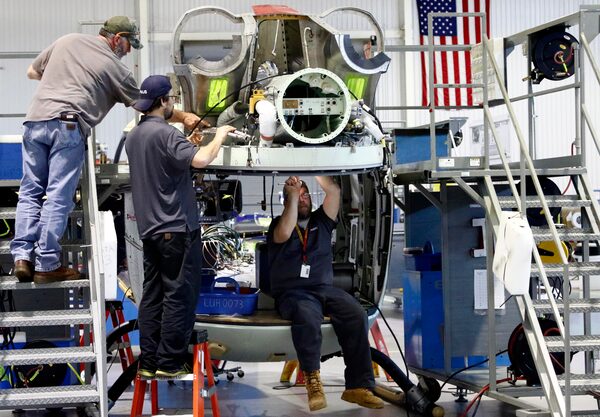
In this May 4, 2018 photo, technicians work on the wiring of a twin-engine Lakota helicopter at the Airbus manufacturing facility in Columbus, Miss.Rogelio V. Solis/The Associated Press
New orders for U.S.-made goods fell more than expected in April, weighed down by declines in demand for transportation equipment and machinery, but the underlying trend continued to suggest strong momentum in the manufacturing sector.
Factory goods orders decreased 0.8 per cent, the U.S. Commerce Department said on Monday. Data for March was revised up to show orders rising 1.7 per cent instead of the previously reported 1.6-per-cent increase.
Economists polled by Reuters had forecast factory orders falling 0.5 per cent in April. Orders advanced 8.3 per cent on a year-on-year basis in April.
The monthly decline in factory orders is likely to be temporary amid reports of strong manufacturing conditions in May. A survey by the Institute for Supply Management last week showed sentiment among manufacturers perking up in May amid a surge in new orders.
Manufacturers, however, complained about rising prices for raw materials, especially for steel. The Trump administration in March announced tariffs for steel and aluminum imports to protect domestic industries from what it says is unfair competition from foreign producers.
Prices are likely to rise even higher following Washington’s decision last week to extend the duties to steel and aluminum imports from Canada, Mexico and the European Union. Some manufacturers also said they could not find skilled workers.
The U.S. Federal Reserve’s latest “Beige Book” report of anecdotal information on business activity collected from contacts described manufacturing as having “shifted into higher gear” in late April and early May. But the U.S. central bank also said “contacts continued to report difficulty filling positions across skill levels.”
Strong domestic demand
Manufacturing, which accounts for about 12 per cent of U.S. economic activity, is being supported by strong domestic and global demand.
U.S. stock indexes were higher in early trading on Monday while prices of U.S. Treasuries were weaker. The U.S. dollar fell against a basket of currencies.
Orders for transportation equipment fell 6.0 per cent, pulled down by a 28.9-per-cent plunge in the volatile orders for civilian aircraft. Transportation orders increased 6.9 per cent in March. Orders for motor vehicles rose 1.0 per cent in April.
Orders for machinery dropped 0.7 per cent after tumbling 3.1 per cent in March. That reflected a decline of 11.6 per cent in orders for mining, oil field and gas field machinery. Orders for industrial machinery fell 10.0 per cent.
But orders for electrical equipment, appliances and components increased 1.8 per cent. There were also increases in orders for fabricated metal products and primary metals.
Unfilled orders at manufacturers rose 0.5 per cent in April. They have increased in five of the past six months. Manufacturing inventories increased a moderate 0.3 per cent, which also bodes well for factory production.
The U.S. Commerce Department also confirmed that April orders for non-defence capital goods excluding aircraft, which are seen as a measure of business spending plans, increased 1.0 per cent as reported last month. Orders for these so-called core capital goods fell 1.0 per cent in February.
Shipments of core capital goods, which are used to calculate business equipment spending in the gross domestic product report, rose 0.9 per cent in April instead of the 0.8-per-cent gain reported last month.
Core capital goods shipments fell 0.7 per cent in March and were up 8.4 per cent year-on-year in April. Business spending on equipment is slowing after double-digit growth in the second half of 2017.
The moderation is occurring despite the Trump administration’s US$1.5-trillion tax-cut package, which came into effect in January. The government slashed the corporate tax rate to 21 per cent from 35 per cent.